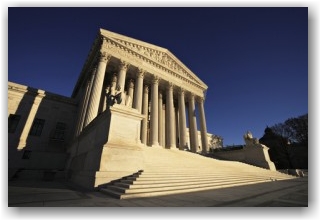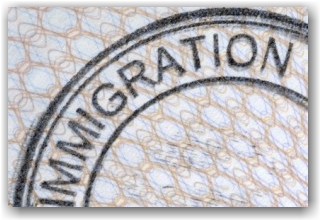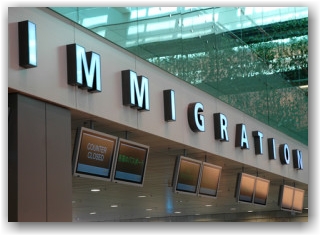July 8th, 2016

This rule implements as an inflation adjustment fines for employing unauthorized workers for Form I-9 paperwork violations, and for immigration-related discrimination. These new fines increase the penalties from 35% to 96% depending on the nature and severity of the violation.
We encourage you to review your policies, procedures and your Form I-9 inventory. Remember, the key to defending any employment related investigation is to evidence that there is and has been a consistent pattern of responsible, good faith effort on the part of the employer in establishing a compliant workforce.
Refer here for the details.
Tags: DOJ, I-9 AUDIT, I-9 Compliance, I-9 Penalties, I-9/E-Verify, ICE, Immigration compliance, Legal Workforce, OSC, USCIS
Posted in DOJ, I-9/E-Verify News, ICE, OSC, USCIS | Comments Off on DOJ issues interim final rule increasing fines 35-96% for employing unauthorized workers
April 14th, 2016

The OSC publishes responses to TAL Letters (Technical Assistance Letters) that they receive from attorneys, employers and other stakeholders. USCIS identifies this circumstance in the I-9 Employer Handbook as an employee who comes forward and indicates that their identity is now different than previously represented (Hmm…) and now wants to “regularize” their employment record. Or, what do you do if you become aware, for instance, that a social security number associated with a particular employee was not legally assigned?
Discussion starts on page 2.
OSC’s TAL implies that if an employer has not consistently-followed a policy of terminating individuals for providing false information during the hiring process, it couldn’t use that policy to justify a termination in this particular scenario. Even if the employer did consistently terminate individuals who were dishonest during the hiring process, OSC implied that this was not necessarily a slam dunk argument either. It is important to note that OSC did not commit itself by concluding that such a termination under the circumstances would not constitute discrimination or be deemed to be a valid legitimate non-discriminatory reason for termination. It simply stated it would depend on the facts and circumstances. Before you go down this road, remember –the USCIS Handbook for Employers provides that “Where an employee has worked for you using a false identity but is currently work authorized, the I-9 rules do not require termination of employment.”
There’s also guidance regarding this for DACA employees that you might wish to review. For more on I-9 compliance please refer to our Employer Resource Center
Tags: E-Verify, I-9 Compliance, I-9 Form, I-9/E-Verify News, ICE, Legal Workforce, Social Security, USCIS
Posted in DACA | DAPA, Department Of Labor (DOL), Employer Compliance, I-9/E-Verify News, ICE, OSC, Social Security | Comments Off on Employee Notifies that I-9 Documents Previously Submitted were not Genuine: What’s an Employer to do?
January 19th, 2016
 The Obama administration took the battle over immigration to the Supreme Court on Friday, formally asking the justices to review a federal court decision that left in place a nationwide injunction against President Barack Obama’s sweeping initiative to grant quasi-legal status and work permits to millions of immigrants here illegally.
The Obama administration took the battle over immigration to the Supreme Court on Friday, formally asking the justices to review a federal court decision that left in place a nationwide injunction against President Barack Obama’s sweeping initiative to grant quasi-legal status and work permits to millions of immigrants here illegally.
DAPA would grant deferred action status to those who have lived in the United States for at least 5 years and have not committed felonies or repeated misdemeanors, and have children who are US citizens or lawful permanent residents. Deferred action is not full legal status, but in this case would come with a three-year, renewable work permit and exemption from deportation. The Court will hear arguments in April and rule by June.
Read more here From Politico here
Tags: DAPA, Deferred Action, Department Of Homeland Security (DHS), Immigration Legislation, Immigration News, Legal Status, Supreme Court, undocumented immigrants
Posted in DACA | DAPA, Department Of Homeland Security (DHS), Immigration Legislation, Immigration News, USCIS | Comments Off on Breaking News! Obama’s DAPA Appeal to Take Center Stage in Supreme Court
January 13th, 2016
 USCIS received 233,000 new H-1B petitions last year against a quota of 85,000, and this year is expected to be even higher for FY 2017. Approximately one-half of the submitted petitions were not accepted for processing. As the economy has grown and and gained momentum, employers have been planning for months and making a list of candidates for whom they want to file H-1Bs. The demand is expected to be huge this filing season, and the quota will be met in lightening speed. There are 5 business days to submit your cases, from April 1 to April 7, 2016 to access the opportunity of securing an extremely limited number of new H-1B slots.
USCIS received 233,000 new H-1B petitions last year against a quota of 85,000, and this year is expected to be even higher for FY 2017. Approximately one-half of the submitted petitions were not accepted for processing. As the economy has grown and and gained momentum, employers have been planning for months and making a list of candidates for whom they want to file H-1Bs. The demand is expected to be huge this filing season, and the quota will be met in lightening speed. There are 5 business days to submit your cases, from April 1 to April 7, 2016 to access the opportunity of securing an extremely limited number of new H-1B slots.
So, planning is of the utmost importance. Here are some important tips to get ready for H-B case filing on April 1st:
- Assess your employment needs. Start to assess the number of H-1B petitions that your firm wishes to file. Coordinate with your immigration provider and assess legal and government filing fees.
- Do you need to obtain Credential Evaluations for your foreign educated applicants? Get this done early as the evaluation services will be swamped. Assess the relationship between the applicant’s degree and the position being offered. Does the degree equate to a 4-year US degree? If not, can the applicant produce employment verification letters so that previous work experience can be used to develop an evaluation that creates a nexus between their education and the offered position and to meet the degree requirement? It takes time to obtain these letters; therefore, close analysis of degree issues is of the utmost importance. These issues are being scrutinized more closely by USCIS each year. Lastly, if you wish to sponsor the applicant for their green-card in the future, make sure that the strategy you adopt for the H-1B can take you into a successful green-card process.
- Get the Labor Condition Application (LCA) early. It can take up to 7 business days to receive LCA’s from the Department of Labor (and longer as the clock ticks toward April 1st). Once you have identified your hiring needs and obtained the necessary documentation to start the H-1B process, file the Labor Condition Application to avoid delays. Even though early filing means a shorter validity period for the H-1B petition, it is still advisable to have a timely filed and certified Labor Condition Application in hand for a complete case filing with USCIS.
- Start gathering necessary H-1B documentation right now. Develop your detailed job descriptions (not a list of requirements, but actual daily job duties and responsibilities). Work with your legal team and the applicants that you wish to sponsor. Obtain degrees, transcripts, credential evaluations, employment letters, status documentation. These are required documents and do take time to analyze and assemble and, if missing, create delays and RFE’s.
- Be prepared for last minute changes in procedures and requirements. Last-minute changes in USCIS and Labor Department processes often arise with each new H-1B filing season. Our office, of course, will keep you apprised as we continue to monitor any changes in procedure or requirements.
We are already accepting H-1B cases for processing and welcome your business. Contact info@immigrationcompliancegroup.com or call 562 612.3996.
Tags: Credential Evaluations, Department Of Labor (DOL), DOL, FY 2017 H-1B, H-1B, H-1B Degree Reqirements, H-1B Job Descriptions, Labor Condition Application, LCA, USCIS
Posted in Department Of Labor (DOL), H-1B Visas, USCIS | Comments Off on It’s Starting to Look Alot Like H-1B Filing Season!
January 6th, 2016
 USCIS is seeking public comments on a proposed rule that would modernize and improve certain important aspects of employment-based nonimmigrant and immigrant visa programs. USCIS is also proposing regulatory amendments to better enable U.S. employers to hire and retain certain foreign workers who are beneficiaries of approved employment-based immigrant visa petitions and are waiting to become lawful permanent residents (LPRs).
USCIS is seeking public comments on a proposed rule that would modernize and improve certain important aspects of employment-based nonimmigrant and immigrant visa programs. USCIS is also proposing regulatory amendments to better enable U.S. employers to hire and retain certain foreign workers who are beneficiaries of approved employment-based immigrant visa petitions and are waiting to become lawful permanent residents (LPRs).
Read the notice of proposed rulemaking published in the Federal Register on December 31, 2015: Retention of EB-1, EB-2 and EB-3 Immigrant Workers and Program Improvements Affecting High-Skilled Nonimmigrant Workers. The public has until February 29, 2016 to comment.
Among other things, the DHS proposals to amend its regulations entail the following:
… To clarify and improve longstanding agency policies and procedures implementing sections of the American Competitiveness in the Twenty-First Century Act (AC21) and the American Competitiveness and Workforce Improvement Act (ACWIA) related to certain foreign workers, which will enhance USCIS’ consistency in adjudication.
… To better enable U.S. employers to employ and retain certain foreign workers who are beneficiaries of approved employment based immigrant visa petitions (I-140 petitions) while also providing stability and job flexibility to these workers. The proposed rule will increase the ability of such workers to further their careers by accepting promotions, making position changes with current employers, changing employers, and pursuing other employment opportunities.
… To improve job portability for certain beneficiaries of approved I-140 petitions by limiting the grounds for automatic revocation of petition approval
… To clarify when individuals may keep their priority date to use when applying for adjustment of status to lawful permanent residence, including when USCIS has revoked the approval of their approved I 140 petitions because the employer withdrew the petition or because the employer’s business shut down.
… To allow certain high-skilled individuals in the United States in E-3, H-1B, H-1B1, L-1, or O-1 nonimmigrant status to apply for one year of unrestricted employment authorization if they:
1. Are the beneficiaries of an approved I-140 petition,
2. Remain unable to adjust status due to visa unavailability, and
3. Can demonstrate that compelling circumstances exist which justify issuing an employment authorization document.
Such employment authorization may only be renewed in limited circumstances.
… To clarify various policies and procedures related to the adjudication of H-1B petitions, including, among other things, extensions of status, determining cap exemptions and counting workers under the H-1B visa cap, H-1B portability, licensure requirements, clarification concerning which H-1B nonimmigrants are exempt from the statutory cap to ensure that those who are contributing to US research and the education of Americans may remain in the USA; and protections for whistleblowers.
… To establish a one-time grace period during an authorized validity period of up to 60 days for certain high-skilled nonimmigrant workers whenever their employment ends so that they may more readily pursue new employment and an extension of their nonimmigrant status.
These proposed changes do not take effect with the publication of the notice of proposed rulemaking. Instead, they would take effect on the date indicated in the final rule when the final rule is published in the Federal Register. Here is the proposed rule. To submit comments, follow the instructions. You may submit comments, identified by DHS Docket No. USCIS-2015-0008, by one of the following methods:
Federal eRulemaking Portal: You may submit comments to USCIS by visiting http://www.regulations.gov. Follow the instructions for submitting comments. By email: You may submit comments directly to USCIS by emailing them to: USCISFRComment@dhs.gov. Please include DHS Docket No. USCIS-2015-0008 in the subject line of the message.
The Department of Labor: Modernizing the Permanent Labor Certification Program (PERM)
DOL is engaging in rule making that will consider options to modernize the PERM program to be more compatible to changes in the US workforce, to further align the program design with the objectives of the US immigration system and the needs of workers and employers, and to enhance the integrity of the labor certification process. This is not expected to be proposed until April 2016.
Tags: AOS Portability, Department Of Homeland Security (DHS), DOL, eb-1, eb-2, eb-3, Employment-Based Immigration, H-1B, H-1B Portability, I-140 Petition, Immigration News, LPR, Proposed Immigration Legislation, Proposed Rules for H-1B and EB Immigration, USCIS
Posted in Department Of Homeland Security (DHS), Department Of Labor (DOL), H-1B Visas, Immigrant Visas (I-140 Petitions), Immigration Legislation, Immigration News, O-1 Visas, USCIS | Comments Off on Employment-Based Immigration Proposals Open for Public Comment
December 16th, 2015

The Department of Justice’s Office of Special Counsel (OSC) and the U.S. Immigration and Customs Enforcement (ICE) have issued a six-page joint Guidance for Employers Conducting Internal Form I-9 Audits that can be viewed here: http://www.justice.gov/crt/file/798276/download
This guidance is a result of a six-month intra-agency initiative to foster greater cooperation across government agencies in the I-9 audit space. The group overseeing this initiative, entitled the Interagency Working Group for the Consistent Enforcement of Federal Labor, Employment and Immigration Laws, is tasked with improving the effectiveness of investigations by ICE and the OSC.
For more
Tags: Department Of Homeland Security (DHS), Employer Compliance, Employment Eligibility Verification, I-9 Audits, I-9 Form, I-9/E-Verify News, ICE, Immigration compliance, Legal Workforce, OSC, Self-Audits
Posted in Uncategorized | Comments Off on OSC & ICE Publish Guidance to Employers on Internal I-9 Audits
October 25th, 2015
 Reports are that DHS has begun circulation of one of Obama’s employment-based executive actions which is also in response to a judge’s order that struck down the existing STEM OPT program for a lack of a notice & commenting period with the issuance of the 2008 interim rule. The public will have 30 days (until November 18) to comment on the proposed rule. You can view the notice in the Federal Register here
Reports are that DHS has begun circulation of one of Obama’s employment-based executive actions which is also in response to a judge’s order that struck down the existing STEM OPT program for a lack of a notice & commenting period with the issuance of the 2008 interim rule. The public will have 30 days (until November 18) to comment on the proposed rule. You can view the notice in the Federal Register here
The Rule will make several changes to the F-1 STEM OPT program. Most importantly, the STEM OPT extensions would increase from 17 to 24 months.
The new rule adds both additional benefits and employer requirements for all individuals and companies utilizing OPT.
Here is an excellent summary of the proposed changes as posted on ILW.com.
:::::::::::::::
Immigration Compliance Group provides US inbound immigration services to individuals and employers throughout the USA and abroad. We specialize in business immigration and have a depth of experience in the IT, healthcare, arts, entertainment and sports industries, among others. Our services include complex business visas for investors, multinational managers, skilled professionals, outstanding individuals of high achievement (O-1, P visas, EB-1 and EB-2 Exceptional Ability cases) and PERM Labor Certification. Our doors are always open for new clients — we extend a 20% discount on the first case with our firm. Contact us at info@immigationcompliancegroup.com or call 562 612.3996. Follow up on Twitter (@immigration_biz) Google Plus and check out our groups on LinkedIn: I-9E-Verify: Smart Solutions for Employers and Immigration InFocus News.
Tags: Department Of Homeland Security (DHS), F-1 Visas, Immigration News, OPT, STEM, STEM Extension, USCIS
Posted in Department Of Homeland Security (DHS), Immigration Legislation, USCIS | Comments Off on Details on the Proposed STEM OPT Rule
October 15th, 2015
 Stakeholders are outraged by the most recent development with the so-called streamlining of the allocation of immigrant visas that are published monthly in the Department of State’s (DOS) Visa Bulletin.
Stakeholders are outraged by the most recent development with the so-called streamlining of the allocation of immigrant visas that are published monthly in the Department of State’s (DOS) Visa Bulletin.
Unless otherwise indicated on the USCIS website at www.uscis.gov/visabulletininfo,
individuals seeking to file applications for adjustment of status with USCIS in the Department of Homeland Security must use the “Application Final Action Dates” charts in the Visa Bulletin for determining when they can file such applications. When USCIS determines that there are more immigrant visas available for the fiscal year than there are known applicants for such visas, USCIS will state on its website that applicants may instead use the “Dates for Filing Visa Applications” charts in the Bulletin. The USCIS website statement is supposed to be posted within one week of the Visa Bulletin publish date.
Applicants for adjustment of status may refer to USCIS for additional information by visiting www.uscis.gov/visabulletininfo. USCIS has indicated on their website (above link) that that you may use the Dates for Filing Visa Applications chart for the corrected October 2015 and November 2015 Visa Bulletins.
Something has absolutely got to change here. This has reached a level of complete and utter absurdity.
Refer here for November filing date information.
For background information on this issue, refer here
Tags: adjustment of status, Department Of Homeland Security (DHS), DOS, Immigrant Visa Allocation, Immigration News, Permanent Residency Applications, USCIS, visa bulletin, Visa Gate
Posted in Department Of Homeland Security (DHS), Department of State, Immigrant Visas (I-140 Petitions), Immigration News, USCIS | Comments Off on DOS/USCIS’ Lame Attempt at ‘streamlining'(?) the Immigrant Visa Process
October 9th, 2015
 With the rash of RFE’s increasing year by year, this article is extremely informative and useful.
With the rash of RFE’s increasing year by year, this article is extremely informative and useful.
The important take away…..Work with evaluators that analyze USCIS policy and trends and that understand the education that is required for the type of visa being applied for. Oftentimes there is a rush to secure an evaluation before nailing down the job title and job description with the client; this is a mistake.
So, whose fault is it REALLY and why does it matter whose fault it is anyway?
Sometimes it is the attorney or evaluators fault, but sometimes it is CIS’s fault.
Sometimes it is the fault of the evaluation but not the evaluator.
Sometimes it is CIS’s fault.
Sometimes it is the candidate’s fault.
Sometimes it is no one’s fault at all.
For more, refer here
We thank Sheila Danzig, TheDegreePeople.com, for this excellent article.
Tags: Credential Evaluators, Department Of Labor (DOL), Education Evaluations, H-1B, Immigration News, LCA, RFEs, Specialty Occupations, USCIS
Posted in Department Of Labor (DOL), H-1B Visas, Immigration News, USCIS | Comments Off on H-1B RFE’s ——Who is to Blame?
September 20th, 2015

Plain and simple, failing to comply with IRCA’s I-9 rules have, and are continuing at a rapid rate, to result in significant fines, loss of access to government contracts, an onslaught of negative publicity, business closure, criminal penalties and even imprisonment. Here are a few examples of recently settled cases in August 2015:
1) Creating discriminatory barriers for immigrants who have permission to work in the United States, $165 civil penalty with $50K in back pay:
http://www.justice.gov/opa/pr/justice-department-settles-discrimination-claim-against-louisiana-crane-construction
2) Requiring non-U.S. citizens, but not similarly-situated U.S. citizens, to present specific documentary proof of their immigration status to verify their employment eligibility, $200K civil penalty: http://www.justice.gov/opa/pr/justice-department-settles-immigration-related-discrimination-claim-against-nebraska-based
3) City of Eugene, OR improperly restricted law enforcement positions to U.S. citizens at the time of hire, even though no law, regulation, executive order or government contract authorized such a restriction. must pay a civil penalty, train its employees about the anti-discrimination provision of the INA and be subject to monitoring by the Justice Department for a period of three years!
http://www.justice.gov/opa/pr/justice-department-settles-citizenship-discrimination-claim-against-city-eugene-oregon
:::::::::::::::::::::
Immigration Compliance Group provides US inbound immigration services to individuals and employers throughout the USA and abroad. We specialize in business immigration and have a depth of experience in the IT, healthcare, arts, entertainment and sports industries, amongst others. Our services include complex business visas for investors, multinational managers, skilled professionals, outstanding individuals of high achievement (O-1, P visas, EB-1 and EB-2 Exceptional Ability cases) and PERM Labor Certification. We additionally provide employer compliance consulting services on proper I-9 (Employment Eligibility Verification) management, auditing, training, and work with our clients to develop a culture of immigration compliance. Our door is open for new clients — we extend a 20% discount on the first case with our firm. Contact us at info@immigationcompliancegroup.com or call 562 612.3996.
Tags: DOJ, Employer Compliance, Employoment Eligibility Verification, I-9 Audits, I-9 Form, I-9 Penalties, I-9/E-Verify News, ICE, Immigration News, Legal Workforce, OSC, Social Security Card, USCIS
Posted in DOJ, Employer Compliance, I-9/E-Verify News, ICE, Immigration News, OSC | Comments Off on Recent DOJ Worksite Enforcement Settlements that Shed Light on Form I-9 Employer Compliance








